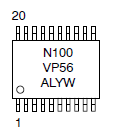NB100LVEP56: Features: • Maximum Input Clock Frequency > 2.5 GHz Typical• Maximum Input Data Rate > 2.5 Gb/s Typical• 525 ps Typical Propagation Delays• Low Profile QFN Package̶...
floor Price/Ceiling Price
- Part Number:
- NB100LVEP56
- Supply Ability:
- 5000
Price Break
- Qty
- 1~5000
- Unit Price
- Negotiable
- Processing time
- 15 Days
SeekIC Buyer Protection PLUS - newly updated for 2013!
- Escrow Protection.
- Guaranteed refunds.
- Secure payments.
- Learn more >>
Month Sales
268 Transactions
Payment Methods
All payment methods are secure and covered by SeekIC Buyer Protection PLUS.

 NB100LVEP56 Data Sheet
NB100LVEP56 Data Sheet











